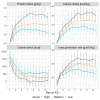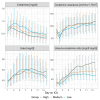The Impact of Protein Feed on the Urea-to-Creatinine Ratio-A Retrospective Single-Center Study
- PMID: 40284158
- PMCID: PMC12029703
- DOI: 10.3390/nu17081293
The Impact of Protein Feed on the Urea-to-Creatinine Ratio-A Retrospective Single-Center Study
Abstract
Background/objectives: The urea-to-creatinine ratio (UCR) serves as a biochemical marker for catabolism in the intensive care unit (ICU). UCR increases mainly due to an elevated urea generation from increased protein metabolism. This study aimed to evaluate the impact of protein intake on UCR progression in ICU patients.
Methods: The inclusion criteria of this retrospective, single-center analysis required an ICU stay of at least 14 days without requirement of renal replacement therapy (n = 346 patients). Patients were grouped based on daily mean protein intake per kilogram between days 5 and 14: low (≤0.8 g/kg/d, n = 120), medium (0.9-1.2 g/kg/d, n = 132), and high (≥1.3 g/kg/d, n = 94). Data on daily protein and calorie intake, calorie deficit, urea generation rate, serum creatinine, urea, UCR and creatinine clearances were analysed. Risk factors for developing a high UCR were determined via logistic regression analysis adjusted for sex, age, bodyweight, disease severity (SAPS III admission score) as well as mean protein intake and calorie deficit during day 5 and 14 on ICU.
Results: Higher protein intake was associated with increased calorie intake, lower calorie deficit, and led to an elevated urea generation rate and higher UCR. Renal function and serum urea trends were comparable between all groups, while creatinine was significantly lower in the high-protein group. Risk factors for developing an elevated UCR included older age, female sex and higher protein intake.
Conclusions: An elevated UCR in the early ICU phase may indicate an increased protein metabolism, not only deriving from catabolism but also from a high protein feed.
Keywords: catabolism; protein metabolism; urea-to-creatinine-ratio.
Conflict of interest statement
The authors declare no conflicts of interest.
Figures


References
-
- Hesselink L., Hoepelman R.J., Spijkerman R., de Groot M.C.H., van Wessem K.J.P., Koenderman L., Leenen L.P.H., Hietbrink F. Persistent Inflammation, Immunosuppression and Catabolism Syndrome (PICS) after Polytrauma: A Rare Syndrome with Major Consequences. J. Clin. Med. 2020;9:191. doi: 10.3390/jcm9010191. - DOI - PMC - PubMed
-
- Ali N.A., O’Brien J.M., Hoffmann S.P., Phillips G., Garland A., Finley J.C.W., Almoosa K., Hejal R., Wolf K.M., Lemeshow S., et al. Acquired Weakness, Handgrip Strength, and Mortality in Critically Ill Patients. Am. J. Respir. Crit. Care Med. 2008;178:261–268. doi: 10.1164/rccm.200712-1829oc. - DOI - PubMed
MeSH terms
Substances
LinkOut - more resources
Full Text Sources
Medical

